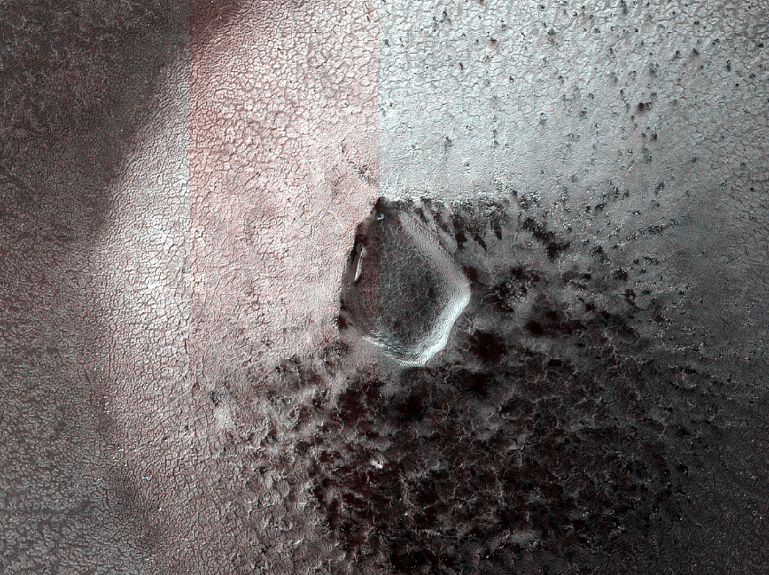NASA's Mars Reconnaissance Orbiter (MRO) has captured an eerie sight on the Martian surface. As the Halloween season approaches, the University of Arizona, operating the High Resolution Imaging Science Experiment (HiRISE) camera on MRO, unveiled an intriguing image from its extensive archives.

Spider on Mars?
The snapshot, taken in May 2022, showcases a crater with two distinct features that have piqued the interest of scientists and space enthusiasts alike.
The first notable element is a series of dark, spider-like formations, creating an uncanny resemblance to a cluster of arachnids traversing the landscape. The second feature comprises geometric polygon shapes similar to dried mud patterns.
The HiRISE team clarified that this image was specifically acquired to investigate the impact of sun exposure on the development of both spider-like formations and polygonal features in terrains of this nature.
In a broader context, the crater stands out starkly against the surrounding Martian landscape, providing an encompassing view of the intriguing terrain.
While these formations may bear a resemblance to spiders, they are, in fact, the result of natural processes occurring on Mars. They stem from the sublimation process, where subsurface ice transforms directly from solid to gaseous. Similar spider-like patterns have been observed in other regions of the Red Planet before.
"Not actual spiders, of course, but formations often caused by sublimation of subsurface ice that create spider-like patterns. This image was acquired to study the influence of exposure to the sun's rays on spider versus polygon development in terrain like this," the HiRISE team said in a press statement.
Read Also : More Americans Prefer NASA Missions Against Killer Asteroids Instead of Mars Expeditions: Survey
Dust Devil on Mars
In related news, NASA's Perseverance rover captured a mesmerizing sight of a Martian dust devil in motion along the western rim of Mars' Jezero Crater last August 30.
Although significantly milder and smaller than Earth's tornadoes, dust devils are crucial in redistributing dust across Mars. Scientists closely examine them to gain deeper insights into the Martian atmosphere and refine their weather models.
Analysis of the imagery allowed mission scientists to estimate that this particular dust devil was situated approximately 2.5 miles (4 kilometers) away in an area nicknamed "Thorofare Ridge."
It was observed moving from east to west at a speed of about 12 mph (19 kph), with an estimated width of around 200 feet (60 meters). While only the lower 387 feet (118 meters) of the swirling vortex are visible in the camera frame, scientists were able to approximate its full height.
"We don't see the top of the dust devil, but the shadow it throws gives us a good indication of its height," said Mark Lemmon, a planetary scientist at the Space Science Institute in Boulder, Colorado, and a member of the Perseverance science team.
"Most are vertical columns. If this dust devil were configured that way, its shadow would indicate it is about 1.2 miles (2 kilometers) in height," he added.
Related Article : NASA James Webb Achieves One of Its First Major Science Goals After Probing the Atmosphere of TRAPPIST Planet

ⓒ 2025 TECHTIMES.com All rights reserved. Do not reproduce without permission.




